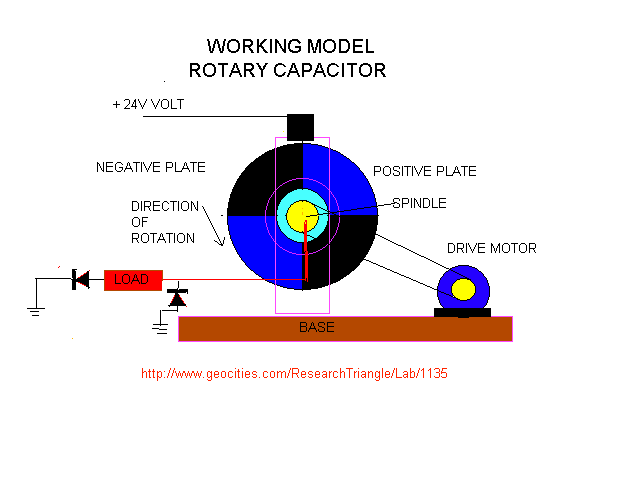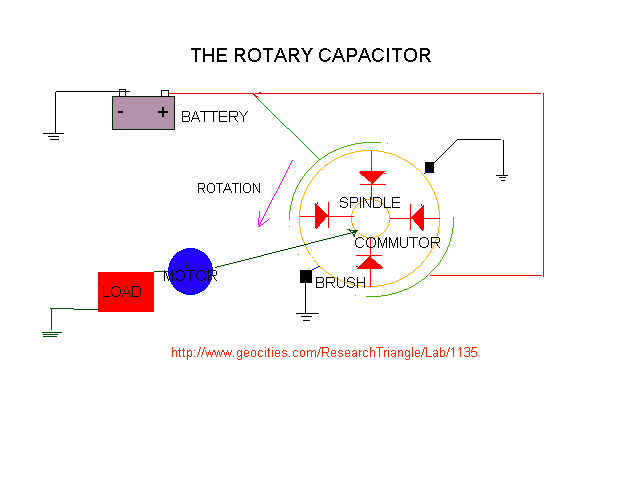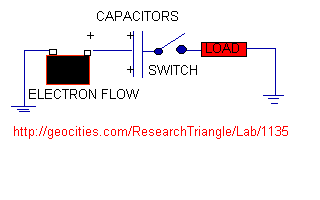

This is an interesting design and concept by experimenter who is still working on improving his concept and will be adding to this page when he get further results. Geoff
If you can offer any suggestions to help him please send to email address as below.
The rotary 'so far' capacitor.
by Gary Hill
I am currently working on the better MkII model, learning from the first one after it self distructed, Well almost, I re-built it, but thealignment is now so bad after the crash .I have to build another one, I have several new Ideas around the same theory, I am hoping for better results. It is still on the drawing board
I will hack up some better drawings if I can get success with my new design.
As the plates come into alignment the free electrons on the spinning plate are statically attracted to the positivley charged stationary plate, (as in any usual capacitor). Electrons flow up from earth powering the load and onto the spinning plate, as the plates spin out of alignment there is for a brief moment no static attraction, the attracted electrons are free and willing to return sharply to earth through the second diode, completing the circuit.
My plates spin very fast with a couple of milimeter gap, I have had some alignment problems due to my crude constuction if the plates touch, they spark. the negative spinning plate is very sharp and carrys a lot of momentum, I would hate to loose a finger, the alignment has never been the same since I knocked the bench and they connected at full speed acouple of nights ago, the thing just about self distructed, MKII willhave larger plates.
I am thinking of some aerodynamic edges to encourage a cusion of air between them, and I have considered using a thicker aluminium plate may be more stable.
A full scale working model would be enclosed in a large cylinder with either a vaccum or possibly a gas dielectric with 50 to 100 or more large rotary plates on the same spindle.
Enclosed also for saftey,Running on low friction or magnetic bearings? with a brushless good eficiency motor, the motor could serve as the pickup mechanism.
I can imagine it being the size of a washing machine on its side.
The plates will fly above each other very closley, on a dielectric gas cusion (I am not sure if there is such a thing as a di-electric gas yet? I am going to do some research) , similar to the way heads fly above the surface of a hard disk drive, as close as possible in order to acheive maximum capacitance.
As the plates aproach each other there is an electrostatic atractive force, encouraging the spin, as they leave each other there is also an electrostatic attraction, as the movement is at 90 degrees to theattraction, there would be minimal energy loss compensated by the motor.
Like trying to remove a suction cup from a surface, it is very easy to move the cup sidewards to remove it as compared with the atractive force f the cup to the surface if you try and pull it strait up. There would be some stability problems, The attraction may cause oscillations in the lates causing the machine to self distruct.
I beleive it would run in over unity if a highly mechanically efficient model was built, Increasing to a highest possible positive voltage (atas good as zero current.) before dielectric breakdown, (in my case air.)
Probably only useful as a battery charger? ( and if you kicked it while it was in opperation you would probably stuff it)
This one is rather crude, But it seems to prove the point to me that it can work so far, I get a negative square wave pulse on the cro as the machine is in operation, -5v is about the max output, with a +24V attractive pressure, the MKII will use a much much higher positive voltage, 3 plates, some sort of plastic insulator, Teflon film hopefully I am searching for it. (got any Ideas) as a dielectric.
I am rigging an old EHT trying to modify the circuit to to vary the high positive output voltage to the max level as a test, The MkII will use fiberglass PCB material type disks and etch the capacitor plate shapes onto the surface, this will allow a closer air gap. and allow me to incorporate many capacitors onto the surfaces, the spinning collector will be double sided PCB material in the middle of a sandwich of 2 single sided etched plates, that will have the high static pressure at either side, a balanced force either side of the spinning collector plate will stop any wobbling due to electrostatic pressure. I have a nice chunky 12v DC electronic brushless motor on the bench ready to power the new model.
I am dreaming of making a large electret to create the necesary electrostatic force, or possibly using an electret as the stationary plate and see if that works, Today I got a gas burner, I am going to make a brick oven and cook one up, My Wife won't have me making it in the kitchen.

Here is a rough drawing, and my original concept

If you set up this circuit, the positive charge on the plate of the capacitor sets up the potential to do work. Aside from making this circuit, you have so far not expended any energy. Throw switch A, electrons will flow up through the load, and onto the plate of the capacitor.
You have done work for free! If you can get rid of the electrons, you can do the work again ,for free.
Gary Hill Author of this article
MCS Systems Engineer III
Page: 1800 252277 - Mobile: 0411114906
Fax: (03) 9275 3454 - DTN:739-3618
Digital Equipment Corporation, Melbourne Australia
